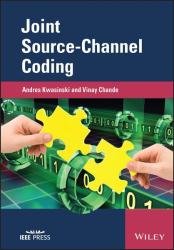Joint Source-Channel Coding
- Добавил: literator
- Дата: 6-11-2022, 12:01
- Комментариев: 0
 Название: Joint Source-Channel Coding
Название: Joint Source-Channel CodingАвтор: Andres Kwasinski, Vinay Chande
Издательство: Wiley-IEEE Press
Год: 2023
Страниц: 403
Язык: английский
Формат: pdf (true)
Размер: 14.97 MB
Joint Source-Channel Coding Consolidating knowledge on Joint Source-Channel Coding (JSCC), this book provides an indispensable resource on a key area of performance enhancement for communications networks.
Presenting in one volume the key theories, concepts and important developments in the area of Joint Source-Channel Coding (JSCC), this book provides the fundamental material needed to enhance the performance of digital and wireless communication systems and networks. It comprehensively introduces JSCC technologies for communications systems, including coding and decoding algorithms, and emerging applications of JSCC in current wireless communications. The book covers the full range of theoretical and technical areas before concluding with a section considering recent applications and emerging designs for JSCC. A methodical reference for academic and industrial researchers, development engineers, system engineers, system architects and software engineers, this book:
Explains how JSCC leads to high performance in communication systems and networks
Consolidates key material from multiple disparate sources
Is an ideal reference for graduate-level courses on digital or wireless communications, as well as courses on information theory
Targets professionals involved with digital and wireless communications and networking systems
To serve these objectives, the book starts with Chapters 1 through 3 that are dedicated to discussing background in communication systems, Information Theory, source coding, and channel coding, as well as to explaining the reason to use JSCC and to present the main classes of JSCC techniques to be covered later in the book. Following this introductory part, Chapter 4 delves into concatenated joint source–channel coding, as a first and basic JSCC technique. Chapter 4 is followed by six chapters where each one is dedicated to an specific approach to JSCC: Chapter 5 covers unequal error protection source–channel coding, Chapter 6 focuses on source–channel coding with feedback, Chapter 7 is dedicated to the study of the quantizer design for noisy channels, Chapter 8 covers error-resilient source coding, Chapter 9 focuses on analog and hybrid digital–analog JSCC techniques, and Chapter 10 discusses joint source–channel decoding. The book concludes in Chapter 11 with a presentation of some recent applications of JSCC, connecting the solutions with techniques seen in earlier chapters, and discussing the emerging and promising design approach for JSCC based on artificial neural networks (ANN).
Скачать Joint Source-Channel Coding
Внимание
Уважаемый посетитель, Вы зашли на сайт как незарегистрированный пользователь.
Мы рекомендуем Вам зарегистрироваться либо войти на сайт под своим именем.
Уважаемый посетитель, Вы зашли на сайт как незарегистрированный пользователь.
Мы рекомендуем Вам зарегистрироваться либо войти на сайт под своим именем.
Информация
Посетители, находящиеся в группе Гости, не могут оставлять комментарии к данной публикации.
Посетители, находящиеся в группе Гости, не могут оставлять комментарии к данной публикации.
